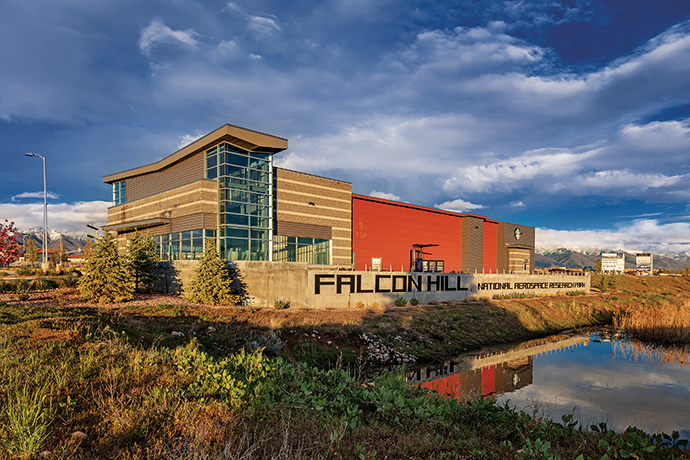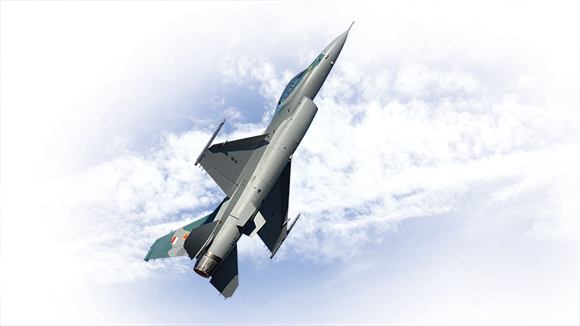Hill Air Force Base — home to the 75th Air Base Wing located at a Utah crossroads between Salt Lake City and Ogden, next to I-15 and near the FrontRunner commuter rail — already contributes over $3.5 billion to Utah’s economy each year. A 550-acre private development next to the base called Falcon Hill Aerospace Research Park, under an Air Force Enhanced Use Lease, will feature over 2 million sq. ft. of commercial space in its first phase, with additional phases planned.
Planning is turning to action at Falcon Hill with the speed of a climbing fighter aircraft and the savvy of a university. In November 2017, after only eight months of construction, officials gathered to open the new USTAR (Utah Science Technology and Research) Innovation Center, an incubator and prototype lab serving the aerospace and defense, advanced materials, composites and outdoor product sectors in Utah. And in December, aerospace firm Orbital ATK — which already has operations and testing in support of the Minuteman III booster at its Utah facilities in Promontory and Bacchus — opened a new office at Falcon Hill to execute the company’s Propulsion Subsystem Support Contract (PSSC) Program with the Air Force.
"It will bring us closer together and give us the direct, quick access needed to run a program like this successfully," said Scott Lehr, president of Orbital ATK’s Flight Systems Group. Lockheed Martin was an initial tenant in another office building at Falcon Hill constructed during 2017.
Founded in 1919 and headquartered in Salt Lake City, privately-held real estate development firm Woodbury Corporation owns and manages over 13 million sq. ft. of property across 12 states, including at Falcon Hill through its Sunset Ridge Development Partners partnership with Hunt Companies.
"Having USTAR at Falcon Hill is a significant boon for the community here, and is just the first of many ‘outside the fence’ tech-focused office projects we envision for this area," Taylor Woodbury, Woodbury’s COO, said at the grand opening. "Much like the Silicon Slopes area down south, our goal is for this new USTAR building to be the cornerstone of the Silicon Hill movement that will help create a thriving tech community in northern Utah."
In an interview, Woodbury says the park’s value proposition — office, R&D, secure communication, and light manufacturing space inside the fence at Hill AFB — speaks loudly to highly specialized corporate tenants.
"In the last 18 months we’ve signed major leases with Northrop Grumman, Lockheed Martin and BAE," he says. "Today we had a first call with a group looking for an additional site. They are trying to choose between three major Air Force bases. Their current existing site is near an Air Force base, but not inside the fence. They claimed that Hill Air Force Base would likely end up at the top of their list because we were able to provide space inside the fence," thus circumventing issues the group has encountered in the past with classified components of their missions outside the fence.
Woodbury explains that the ultimate goal behind an Enhanced Use Lease is to create value for the Air Force out of under-utilized ground at a military base. "At Falcon Hill, a percentage of every dollar of rent that is paid to a private building is put in an account to build future Air Force buildings," he says. "To date, the Air Force has received new buildings, new infrastructure, a new gate and building demolition, all as a result of Falcon Hill. When companies make the decision to locate at Falcon Hill, they not only land in the best possible location to service their customers, but their rental payments end up funding buildings for the Air Force. For example, a major mission at Hill received 25,000 square feet of office space in 2015 as a result of contractors leasing space at Falcon Hill."

As explained by the national Association of Defense Communities, "at a time when federal funds for the operations and maintenance of military bases can be scarce, enhanced use leasing, or EUL, provides the services with an option to make the most of what they have and are not even using. Through an EUL, military departments can lease non-excess land on domestic bases to private-sector developers or public entities. In exchange, the developers or public bodies will build or renovate facilities for the services to use at their bases, make cash lease payments to the military, or both. For defense communities adjacent to the bases, the benefits primarily include the generation of jobs and tax revenue. Defense communities also believe that EUL projects can help the services operate their bases more efficiently, making them valuable to the services and perhaps protecting the bases from future closures or mission losses."
Layers of Infrastructure
Asked to describe the park’s unique infrastructure advantages, the first thing Woodbury mentions is the ability to locate within a Tier-1 secured fence. "It’s a level of security that would be very expensive to replicate outside of a military base," he says. Also, there are special assets for specialized tenants.
"People think about infrastructure to mean the roads, rails, and airports, but they forget about aspects of government infrastructure that provide huge advantages to the right tenants," he says. For example, the federal government will likely construct a $105-million missile motor storage facility for the F-35s at Hill Air Force Base in 2019. For the companies that are working on the F-35, this new government facility is another in a long list of buildings that make locating at Hill make sense. The runway at Hill, the software development facilities, and the Utah Test and Training Range are all examples of ‘infrastructure’ that makes Hill an ideal place for companies to locate."
Industries Association’s
2018 Facts & Figures report,
the U.S. aerospace and
defense industry supports
2.4 million
American jobs, paying an
average wage of
$91,500
– 81 percent above the
national average.
How do other developments in the region and around the state complement what Woodbury and his team are doing at Falcon Hill?
"We are big believers in the idea that a rising tide raises all boats," says Woodbury. "We love everything the state is doing to try to attract more business and economic activity."
He also praises the partnership of Davis and Weber counties in laying the groundwork. "The creation of better transportation and rail infrastructure up north and the expansion and development plans at Ogden Airport have the area poised to provide excellent locations for companies shopping in the area," he says. "Lastly, the investment by Utah State University and Weber State in new programs catered to high technology manufacturing is going to pay off huge in the future.
"You aren’t going to find a better trained workforce in the state," he says, "than what Davis and Weber county can provide."

